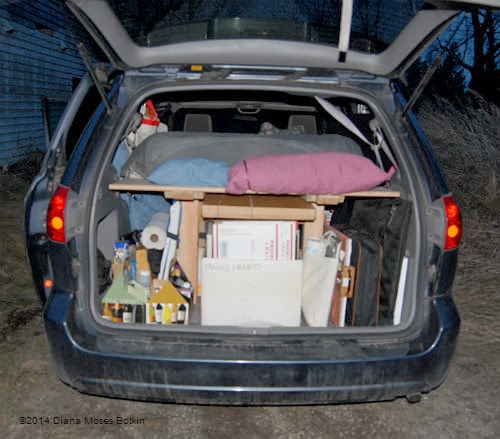I've been traveling, studying at the Artist Guild Week in Scottsdale, gallery hunting, painting, etc. Here's a photo of my van all packed for the trip with art, painting and drawing supplies and a lot more. The snow and ice thawed just in time for me to pack up and drive out of our lane. I'll catch you all up on trip highlights later.
Meanwhile, please read on for some helpful painting tips. Perhaps you know these already, but I hope there is something new for you here in these shared tidbits.
Removing Paint
Maybe you've already heard that isopropyl alcohol removes dried paint from your palette or other places? If not, it's a handy tip. I found out about this over 20 years ago, accidentally. One of my children walked past a large oil painting with a loaded toothbrush. When I wiped the smear of toothpaste from the painting, it removed the paint down to the lead priming. I had to ask what was in the toothpaste that would do that!? Isopropyl!
So next time you notice a smear of paint on the door frame (from when you answered the phone in a hurry with a loaded brush in your hand?), just apply a little rubbing alcohol on the mark. Be careful, though, isopropyl might also remove furniture varnish. I accidentally discovered this too, almost 30 years ago when I wiped a dusty end table with a wet wipe. (Not all baby wipes contain alcohol, however.)
The alcohol is handy stuff, though, for cleaning a painting palette. I also use it to clean up paint spatters from sinks and counters. I carry a bottle with supplies in my car when I'm out plein air painting to combat paint marks on my dashboard and steering wheel. And it's handy in a pinch when there is no place to wash hands out in the wild.
Glass Palette
Speaking of palettes, if you want to use a glass one, tempered glass will not easily break. This material can be ordered from art suppliers, glass companies, or you can use a tempered glass cutting board on the smooth side. A glass palette can be cleaned of dried paint with a razor blade. Alcohol works too.
For my plein air painting box, I've painted my glass palette a medium grey on the underside, and attached it to the mixing area with epoxy. In the studio I use an old tempered glass cutting board set over a medium tone panel (see photo).
Saving Paint, Lids, Space
When I have leftover paint at the end of painting sessions, I either cover my palette with plastic kitchen wrap, or transfer the paint dabs to a small air tight container (such as tupperware) and put the whole thing in the freezer. Especially if I will not get back to painting the next day, the freezer is a safer bet for keeping the paint useable.
 Another helpful practice is to save a few lids from used up painting tubes. Clean them of dried paint (use that handy isopropyl again) and add a few to your painting supplies and plein air box. That way, if you lose a tube lid down a ravine, or break one, you'll have an easy replacement.
Another helpful practice is to save a few lids from used up painting tubes. Clean them of dried paint (use that handy isopropyl again) and add a few to your painting supplies and plein air box. That way, if you lose a tube lid down a ravine, or break one, you'll have an easy replacement.I confess I'm a light weight and hate to carry a lot of heavy stuff when painting out. One of the ways I l keep supplies from being heavy in my plein air box is to pack almost used up tubes of paint. I make them even lighter in weight (and a little tidier for my limited space in the box) by cutting them down.
You can do this by squeezing the remaining paint in the tube to the top, and smoothing out the paint tube. I do this with the rounded end of my pliers. Then I take an old pair of scissors and cut the tube on the flattened part, about a half inch from where the paint is. Crimp the bottom with canvas pliers (or regular pliers can do the job in a pinch.. ha). Fold up the crimped edge and pinch it down well with the pliers, then fold up again. Voilà, a shorter, lighter, and neater tube of paint!
Baby Oil or Vegetable Oil for Cleaning
Also in my painting box is a small bottle of baby oil. It is handy for cleaning oil paint off hands (or the face if you are a really wild painter). At home, I use the bottle of the baby oil for cleaning hands. It can also clean paint out of brushes along with some dish soap. Baby wipes are also good for cleaning up paint.
And vegetable oil can also be used to clean hands or can be used to clean up brushes rather than using solvent.
Okay, that's it for now. Happy painting!















